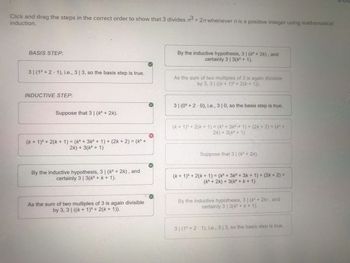
Advanced Engineering Mathematics
10th Edition
ISBN: 9780470458365
Author: Erwin Kreyszig
Publisher: Wiley, John & Sons, Incorporated
expand_more
expand_more
format_list_bulleted
Question
Please help me with this two questions. I am having trouble understanding why the answers are incorrect and what the correct answer is. Please provide the correct answer to the following 2 questions below
Thank you

Transcribed Image Text:Arrange the given steps in the correct order to prove that 3" <n! if n is an integer greater than 6, using mathematical induction.
Rank the options below.
Suppose that for some k> 6, 3k <k!
3k+1 = 3.3k
3k+1 < (k+1).k!
For n=7, 37=2187 < 7! = 5040.
3k+1 < (k+1)!
3k+1 < (k+1).3k
to search
X
4
X
2
6
3
X
5
X
< Prev
14 of 16
Next >
E

Transcribed Image Text:Click and drag the steps in the correct order to show that 3 divides n³ + 2n whenever n is a positive integer using mathematical
induction.
BASIS STEP:
31 (13+2 1), i.e., 3 | 3, so the basis step is true.
INDUCTIVE STEP:
Suppose that 3 | (k³ + 2k).
By the inductive hypothesis, 3 | (k³ + 2k), and
certainly 3 | 3(k² + 1).
As the sum of two multiples of 3 is again divisible
by 3, 3 | ((k+1)3 + 2(k + 1)).
31 (03+2 0), i.e., 3 | 0, so the basis step is true.
(k+1)3 + 2(k + 1) = (k³ + 3k² + 1) + (2k + 2) = (k³ +
2k) + 3(k² + 1)
(k+1)3 + 2(k+1) = (k³ + 3k² + 1) + (2k + 2) = (k³ +
2k) + 3(k² + 1)
Suppose that 3 | (k³ + 2k).
By the inductive hypothesis, 3 | (k³ + 2k), and
certainly 3 | 3(k² + k + 1).
As the sum of two multiples of 3 is again divisible
by 3, 3 | ((k+1)3 + 2(k + 1)).
(k+1)3 + 2(k+1) = (k³ + 3k² + 3k+ 1) + (2k + 2) =
(k3 + 2k)+3(k² + k + 1)
By the inductive hypothesis, 3 | (k³ + 2k), and
certainly 3 | 3(k² + k + 1).
31 (13+2 1), i.e., 3 | 3, so the basis step is true.
Expert Solution
This question has been solved!
Explore an expertly crafted, step-by-step solution for a thorough understanding of key concepts.
Step by stepSolved in 3 steps with 3 images

Knowledge Booster
Similar questions
- The sum of two numbers is 22 and their product is -48. Let x = one of the numbers. Identify all the statements below that are correct.arrow_forwardFollow the instructions given in the photo. Kindly provide a COMPLETE and CLEAR solution. Answer it ASAP because I really need it right now.The answer should be typewritten.arrow_forwardUse the table and info in both photos to solve for MSE, MSTR and F showing the answers in the appropriate box in the second photo. All info is in both photos. please answer clearly and explain. Thank youarrow_forward
- please could you solve the questions are highlighted with yellow color. please show all work.arrow_forwardI have this question on my homework and I don't see a pattern. I have to explain how the trick works. "Think of a number. Add 17. Double the result. Subtract 4. Double the result. Add 20. Divide by 4. Subtract 20. Your answer will be your original number."arrow_forwardI want all solved please thanks for first 3arrow_forward
arrow_back_ios
SEE MORE QUESTIONS
arrow_forward_ios
Recommended textbooks for you
 Advanced Engineering MathematicsAdvanced MathISBN:9780470458365Author:Erwin KreyszigPublisher:Wiley, John & Sons, Incorporated
Advanced Engineering MathematicsAdvanced MathISBN:9780470458365Author:Erwin KreyszigPublisher:Wiley, John & Sons, Incorporated Numerical Methods for EngineersAdvanced MathISBN:9780073397924Author:Steven C. Chapra Dr., Raymond P. CanalePublisher:McGraw-Hill Education
Numerical Methods for EngineersAdvanced MathISBN:9780073397924Author:Steven C. Chapra Dr., Raymond P. CanalePublisher:McGraw-Hill Education Introductory Mathematics for Engineering Applicat...Advanced MathISBN:9781118141809Author:Nathan KlingbeilPublisher:WILEY
Introductory Mathematics for Engineering Applicat...Advanced MathISBN:9781118141809Author:Nathan KlingbeilPublisher:WILEY Mathematics For Machine TechnologyAdvanced MathISBN:9781337798310Author:Peterson, John.Publisher:Cengage Learning,
Mathematics For Machine TechnologyAdvanced MathISBN:9781337798310Author:Peterson, John.Publisher:Cengage Learning,


Advanced Engineering Mathematics
Advanced Math
ISBN:9780470458365
Author:Erwin Kreyszig
Publisher:Wiley, John & Sons, Incorporated

Numerical Methods for Engineers
Advanced Math
ISBN:9780073397924
Author:Steven C. Chapra Dr., Raymond P. Canale
Publisher:McGraw-Hill Education

Introductory Mathematics for Engineering Applicat...
Advanced Math
ISBN:9781118141809
Author:Nathan Klingbeil
Publisher:WILEY

Mathematics For Machine Technology
Advanced Math
ISBN:9781337798310
Author:Peterson, John.
Publisher:Cengage Learning,

